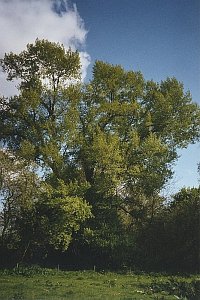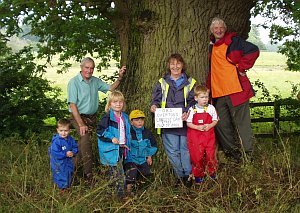Notable and ancient trees of Overton
 Between 2004 and 2006 John Smith and Jim Stickland undertook to survey an area within a 1 mile radius of Overton village centre to record ancient trees. For each tree they recorded species, location, girth at chest height and condition. In total 450 trees were surveyed.
Between 2004 and 2006 John Smith and Jim Stickland undertook to survey an area within a 1 mile radius of Overton village centre to record ancient trees. For each tree they recorded species, location, girth at chest height and condition. In total 450 trees were surveyed.
Ancient trees include:
- Trees of interest biologically, aesthetically or culturally because of their great age
- Trees in the ancient or third and final stage of their life
- Trees that are old relative to others of the same species
Ancient trees are very significant for biodiversity as their large size and irregular shapes provide a habitat for a vast array of organisms such as mosses, lichens, fungi, insects, birds and mammals.
Results
27 species were recorded, with Oak the most common (142 trees), followed by Sycamore (57), Ash (47), Beech (41) Horse Chestnut (28) and Lime (25). (View full list). Interestingly, 2 specimens of the rare black poplar were also recorded (picture right).
 Although girth alone cannot determine the age of a tree as trees grow at different rates in different conditions and different species grow at different rates, girth can still give an indication of age as larger trees are generally older. Thus, in Britain broadleaved trees with a girth of 3 meters (10 feet) or more will often be in excess of 100 years old. In this survey, 135 of the 450 recorded trees were greater than 3 m in girth, with again Oak trees the most abundant (43) followed by Ash trees (16). (View full list). Thirteen trees were over 4.5m (15ft) in girth. The largest oak tree was 5.6m (18'3'') in circumference (picture left).
Although girth alone cannot determine the age of a tree as trees grow at different rates in different conditions and different species grow at different rates, girth can still give an indication of age as larger trees are generally older. Thus, in Britain broadleaved trees with a girth of 3 meters (10 feet) or more will often be in excess of 100 years old. In this survey, 135 of the 450 recorded trees were greater than 3 m in girth, with again Oak trees the most abundant (43) followed by Ash trees (16). (View full list). Thirteen trees were over 4.5m (15ft) in girth. The largest oak tree was 5.6m (18'3'') in circumference (picture left).
You may wish to follow the Sustainable Overton Tree Trail (1.1 MiB/PDF).
A detailed report is available to download from our online library in the 'resources' section of this web site.
